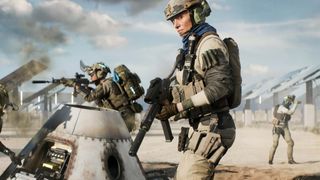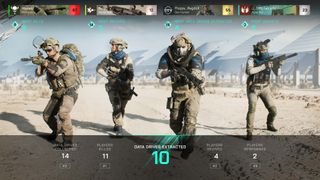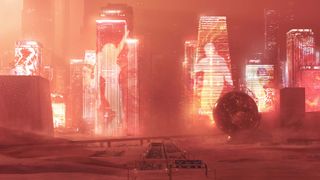Laptop Mag Verdict
Where past Battlefield games have felt too conservative, Battlefield 2042 is massively ambitious to a fault. Some of the changes reinvigorate the franchise’s aging formula, but this latest entry ultimately spreads itself too thin.
Pros
- +
Breathtaking visuals
- +
Excellent gameplay and tons of customization options
- +
Specialists bring new ways to play
- +
Hazard Zone and Portal are welcome additions
Cons
- -
Bugs and more bugs
- -
Large maps and 128 players can be problematic
- -
No voice chat at launch
- -
Too many modes means some get diluted
- -
Needs a “no PC” toggle for crossplay on consoles
Why you can trust Laptop Mag
Massive in scope and filled with fresh ideas, Battlefield 2042 doesn’t belong in the collection of copy-and-paste rehashes of this year. If anything, this latest entry in the nearly 20-year-old franchise is overflowing with concepts. At its worst, BF2042 feels messy and disjointed. Not every addition is welcome, and the blending of old and new doesn’t always work. But there was a moment in my 15-hour reviewer’s play session where everything came together, and DICE’s vision for the future of Battlefield cleared from the smoke.
That moment was in Hazard Zone, a new game mode where squads are tasked to collect hard drives and extract them. What seems like a simple concept is modernized by a clever feast or famine dilemma and the specialist classes introduced for the first time in Battlefield 2042.
Squad strategy at its best
Squads drop into a map together and collect drives randomly scattered across the warzone. Each of the four members can hold up to three for a total of 12 drives. To “win” you must secure these drives by rendezvousing to an extraction zone and boarding an MV38 Condor without being eliminated. If every squad member is killed, the game is over. If one of them is finished off, they cannot respawn unless a teammate visits a Reinforcement Uplink, or what is essentially a respawn station.

Adding to this high-stakes experience is a risk or reward system in which it’s up to your squad to decide when you want to attempt an extraction. You don’t need all 12 drives before doing so. The more you’ve gathered, the more points you gain, but every extra minute you spend delaying extraction could mean losing it all. If your team is eliminated, you go away empty-handed.
In our first round, my squad played it safe by attempting an extraction after collecting only one data drive. We were successful, but only received a small reward. Our risk threshold expanded as we finalized our strategies and determined the best composition of specialists. Emboldened by our success, we pushed further in the next round, but quickly learned of the dangers of Manifest, a port map covered with shipping containers.
Luckily, we’d prepared as best we could. One of my squad members fought as recon soldier Mackay, using his grapple gun to zipline to the top of a container stack and lay down suppressing fire. Another teammate put down a shield for the rest of us as we took fire from multiple enemy squads. All the while, I had deployed my drone to scout out the map. Our tactic worked -- we cleared off the battlefield before jumping into the extraction vehicle with enough hard drives to buy us all the weapons and items we wanted for the next few rounds (using a currency called Dark Market Credits).

Battlefield is at its best when its new ideas come together, and no experience does it better than Hazard Zone. Other modes stumble when introducing new concepts to their classic setups. Take Conquest, for example. While the specialists don’t compromise the mode in any significant way, some of these new characters don’t feel useful. As a reminder, specialists replace the old class system; they are named soldiers, each offering unique abilities and gadgets. Weapons are shared across all specialists so you can use a sniper rifle then switch to an assault gun without having to change specialists -- it’s a significant departure from the old class system which consisted of only Assault, Medic, Recon, Engineer.
Modernizing a decades-old formula
With a wide-ranging set of abilities and gadgets, each specialist feels distinct. Flying around in a wingsuit as Sundance is a very different gameplay approach than blowing through a wall of enemies with Dozer’s shield. As was the case with the previous class system, you’ll be successful in Battlefield 2042 by loading out with the specialists best suited for whichever scenario the situation requires. As a longtime Battlefield player, I was weary of the changes. However, I now appreciate them for what they are: a modernization of the previous four-class setup with loads more complexity. And that complexity will only expand as DICE adds more specialists to the party.

Those worried about balance should feel reassured that no specialists stood out as being overpowered (but see below). Though a few seemed ineffective. My squad had success filing behind Dozer’s practically indestructable riot shield (DICE is in the process of nerfing this character) and having Falck as a medic is necessary for almost every scenario. However, Angel’s ammo crate was never needed and Ji Soo Paik’s EMG scanner is only effective in close-quarter combat. Finding the best composition of specialists is important when you move through a map as a squad -- if you’ve played Overwatch, you get the idea.
And this brings me to my biggest fear about Hazard Zone. DICE has always encouraged squad play as a core mechanic of the franchise, but it is more important than ever in Hazard Zone and now, with the introduction of specialists, even the other modes. Without a squad of four people on comms, I don’t see how you could be successful. Coordination is so key that even having one person going solo could ruin your chances of escaping.

If specialists are the biggest change to Battlefield then the larger, multi-sectored maps are next up. The maps are gigantic. Hourglass, set in Doha, features a massive stadium, a strip of desert, and a huge cityscape; On Discarded, set in India, you’ll find enormous discarded ships stranded on beaches.
The landscapes are diverse but felt lifeless in my relatively brief time with the game. Where past games were modest in placing soldiers within a single town, environment, or structure, Battlefield 2042 thrusts you into massive sandbox zones, each with multiple points of interest. It makes for some grandiose moments but, when coupled with the increased 128 player count (on PC, Xbox Series X, and PS5), rounds can feel overwhelming.
Conquest and Breakthrough on diverging paths
This is especially the case in Conquest, Battlefield’s de facto mode of the past few decades. Squads and even individual players no longer have the power to shift the outcome of a match. With so many other players on the map, nabbing a control point, no less an entire sector (a cluster of control points), by yourself is out of the question. And even if you do take over a point, getting to the next one means traversing a wide-open landscape. I found myself staying within one sector for an entire round, doing all I could to keep control of my small section of the map. All the while, battles ranging around me would ultimately decide if my team would be victorious. Battles I felt far removed from.

The larger maps aren’t so much a problem in Breakthrough, which involves a team moving linearly across a map as they fight to gain control of or defend two points within a sector. This creates natural funnels of soldiers. Battles are hectic, but you at least have a grasp of where things stand and what you can do to help your team. I’ve played Battlefield’s Conquest mode since the original 1942 release. But so far in Battlefield 2042, Breakthrough and Hazard Zone are my modes of choice.
This leads me to the AI, which populates a server if 128 humans (or 64 or 32) aren’t available. In short, the bots are bad. I’m talking, standing around with guns at their side in the middle of a firefight bad. One thing to note here is that there are different AI difficulty settings, EA possibly made the infamously bad press members feel good about themselves by setting it to the easiest difficulty. Regardless, the AI presents no challenge, and putting a few bullets into Sergeant Joe Schmo wasn’t rewarding.
Excellent gameplay with a modern twist
Having said that, gunplay remains a bright spot in Battlefield 2042. Excellent audio mixing combined with true next-gen graphics and realistic weapon physics gives BF the weighty, tactile gameplay you don’t get from Call of Duty or similar arcade shooters. This is a war simulator first, just taken to the extreme.

There are 22 weapons in Battlefield 2042, each with dozens of attachments that, for the first time, can be customized on the fly during a match. You can swap sights, ammo cartridges, and muzzles using the new attachment system. This means you can use a 4x zoom while you’re picking enemies off from a distance then switch to a 1x reflex sight as you get closer to their line. While it doesn’t prevent you from the inevitable shorthanded fight, the ability to tinker with your weapon should give you at least a slim chance of survival in almost every combat situation.
Of course, vehicles remain a key element in Battlefield and one way the game differentiates itself from other first-person shooters. For combat soldiers, they are bad news. I’m already strongly against lumping PC players into crossplay (in any game) due to the advantages of using a keyboard and mouse. But good luck defending yourself against a seasoned Battlefield pilot who is playing on PC while you’re fiddling around with joysticks. Take this as my request to DICE to add a “No PC players” option in crossplay to give PlayStation and Xbox gamers better odds.
History repeats itself
Finally, there is Battlefield Portal, the strangest game mode yet. There are two things going on here. The first feature lets you build your own server using developer-like tools to dictate the rules. In my review session, that meant 32 players fought in a deathmatch round using only an RPG or melee knife. Oh, and I almost forgot, reloading the RPG required you to jump five times. It was a bizarre experiment and I speak for my entire squad when I say that I wanted it to end after the first two rounds.
Server creation and modification are done online through “The Builder,” a web interface that makes you a developer using a drag-and-drop GUI. You can take the simple route with presets or go into the weeds and act as a pseudo-developer using conditions and subroutines. It all works well, and I had no problems creating a from-the-ground-up experience.

My fears about Portal are twofold. With so many game modes, the Battlefield player base is already splintered. Add more user-based servers and you wonder whether there are enough people to fill empty slots. Especially when each map could have 128 of those slots. I also fear the rules won’t be clearly defined when players are looking to jump into a server. The last thing you want is to jump into a game only to find out that your team can only use shock paddles.
Now, onto the second, more exciting part of Portal: playing legacy maps from Battlefield 1942, Battlefield: Bad Company 2, and Battlefield 3. This is a fine selection of past games, though I do want to plead with DICE to give Battlefield 2 some love. Being transported back to Arica Harbor from Bad Company 2 or Caspian Border from Battlefield 3 felt uncanny. Even more unsettling was the lack of updates made to these maps. These aren’t just old maps -- you’re playing the old games exactly as they were at launch. That means you can’t go prone in Battlefield 1942 or 3, there are no vehicle drops, and you need to adapt to using clunky, antiquated weapons. It’s an interesting decision from DICE to keep things untouched.

While I can appreciate the reverence for these old games, the lack of quality of life features can be frustrating. For example, traversing the Battlefield 1942 map El Alamein was a test in patience that I quickly failed after playing the frenetic, white-knuckled rounds in the main game. And destroying tanks in the original Battlefield was futile -- launching your entire rocket inventory at a Sherman left only a few dents in the side.
I don’t want to sound too harsh, though. Replaying these maps after so many years was a real joy. Remembering my favorite hiding spots in Battle of the Bulge or capturing bases in the same ways I had done 10 years ago on the Battlefield 3 Caspian Border map was a wonderful jolt of nostalgia.
Why Portal is comprised of these two seemingly disparate parts baffles me. Mixing them further muddies the waters of a game that already feels disjointed. If it were up to me, I’d keep the custom game creation in Portal but move the old game type to a new mode (Battlefield Vault, perhaps?).
An infestation of bugs
Now let’s talk about bugs. Why EA even released the BF2042 beta remains a mystery -- you don’t take a prospective buyer to a fixer-upper when significant repairs are needed to make the house livable. Unfortunately, the final product shows some cracks in the foundation. Matchmaking, particularly on day one of my reviewer’s program, was a mess. One of my teammates missed two matches, or about an hour of playtime, attempting to squad up.

Some bugs are worse than others. My first attempt to play Breakthrough during the early-access period was unplayable. The server I joined was only populated with one team. There were no enemies. Worse, the ticket counter was sent to infinite and the intro music played loudly on repeat. I exited, played a few rounds of Conquest, then tried Breakthrough again. Guess what happened? It put me right back into that broken service some 30 minutes later!
So, should this game have been further delayed -- the answer: yes. But we’re already into November and video games are an easy stocking stuffer. DICE and EA want to capitalize on the holiday spending, even if it means sacrificing the game to do so. If this means more people playing, resulting in quicker matching times, then that risk may be worth early uproar. It won’t be if these glitches scare away the Battlefield’s most loyal followers. What might delay a purchase are some baffling omissions to the launch version of this game, namely the lack of voice chat.
Battlefield 2042 conclusion
Battlefield 2042 feels like a Hail Mary pass in its ambition. But just like a 50-yard toss to the endzone, the latest first-person shooter in this long-running franchise trades refinement for a see-what-sticks approach. By spraying shots instead of sniping for a focused experience, DICE risks fracturing its fanbase resulting in some modes losing relevance (remember Firezone?).
And yet, once the bugs are addressed, Battlefield 2042 has something for everyone. Those who want a high-octane FPS with a fresh class system inspired by hero shooters can suit up for Conquest or Breakthrough modes. Groups of four itching for strategic gameplay and teeth-gritting down-to-the-wire moments should consider Hazard Zone. And those who want a more classic Battlefield experience can enter the Portal where some of the best maps from the franchise are brought back to life.
Battlefield 2042 is flawed, but the core gameplay feels as refined as ever and most of the major changes introduced to the franchise liven an aging formula. Best of all, the new game modes mean there is a battle for every gamer in this war.
Phillip Tracy is the assistant managing editor at Laptop Mag where he reviews laptops, phones and other gadgets while covering the latest industry news. After graduating with a journalism degree from the University of Texas at Austin, Phillip became a tech reporter at the Daily Dot. There, he wrote reviews for a range of gadgets and covered everything from social media trends to cybersecurity. Prior to that, he wrote for RCR Wireless News covering 5G and IoT. When he's not tinkering with devices, you can find Phillip playing video games, reading, traveling or watching soccer.

